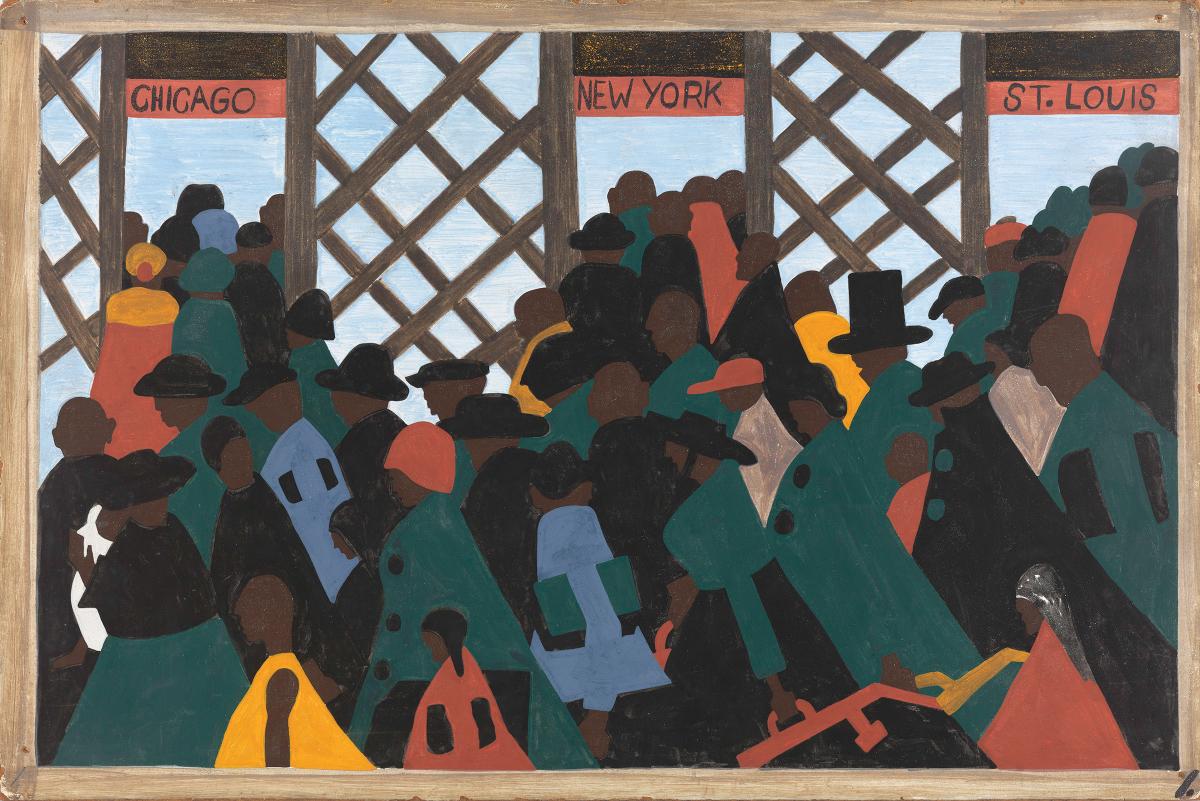The Migration Series, Panel no. 1: During World War I there was a great migration north by southern African Americans.
Jacob Lawrence ( between 1940 and 1941 )

In a century when painting has shifted away from narrative, Lawrence is a master storyteller, bringing to life important historical events by drawing upon his emotional responses to them. Profoundly affected by the Harlem Renaissance of the 1920s and 1930s, he was first exposed to art in an after school program at the Utopia House, where classes were taught by Charles Alston, later his mentor at the Harlem Art Workshop. Dissatisfied with the limited curriculum in the New York public schools, Lawrence attended lectures on black culture and exhibitions of African art at the 135th Street Public Library, the intellectual hub of the community.
When Lawrence began painting The Migration of the Negro in 1940, it was his most ambitious project to date, amplifying his earlier genre scenes and historical series on Toussaint L’Ouverture, Frederick Douglass, and Harriet Tubman. Broad in scope and dramatic in exposition, this depiction of African-Americans moving North to find jobs, better housing, and freedom from oppression was a subject he associated with his parents, who had themselves migrated from South Carolina to Virginia, and finally, to New York.
Lawrence began to research the subject at the 135th Street Library in 1939. After many months of reading and taking notes, he made sketches for the series. Gwendolyn Knight, a painter who was to become his wife, helped him identify memorable scenes and assisted in gessoing the panels and writing the inscriptions. Enthralled by fourteenth- and fifteenth-century Italian paintings he had seen at the Metropolitan Museum of Art, Lawrence used their medium—tempera—with a craftsman’s mastery. To keep the colors consistent, he placed the panels side by side and painted each hue onto all the panels before going on to the next color. Perhaps it was this approach that resulted in a sense of collective unity, even though each panel can stand on its own.
Searing in their immediacy, the works show only essential imagery. Flattened, angular forms, strong diagonals, and contrasts of light and shadow contribute to the dynamism of the images. Although Lawrence used a limited palette, he arranged the colors to form focal points to direct the viewer’s attention. Some pictures are self-contained; others are more expansive. As the narrative unfolds, from image to image, the vantage point, compositions, and details change—in a manner reminiscent of a film. In some panels, figures dominate; in others, the setting propels the story. The people are not individualized; rather, they represent collective characteristics. However, Lawrence never lost sight of the human drama. In all of his work, the human content is paramount.
Lawrence varied his emphasis to reveal the depth of the story. Motion and anticipation are dramatically conveyed in Panel No. 3, where the pyramid of people, gazing beyond the picture’s edge, forcefully echoes the arrangement of the flying birds. The empty space connotes an unknown future. In contrast, the nightmarish scene in Panel No. 51 reduces the human presence to a few silhouettes in the windows of burning buildings, an indication that the migrants did not always find a better life. Panel No. 57, in its central monumental form, eloquently captures the dignity of the working woman.
Public acceptance for The Migration of the Negro has been strong since the series was first shown, demonstrating the continuing relevance of its theme. A seminal work in twentieth-century art, it was a manifestation of Lawrence’s ethnic pride and his desire to reveal events that he felt should be known: “It was… so much a part of my life. I became conscious of these things when I was eight or nine years old, and this consciousness remained, and this is what you see in the Migrations.”